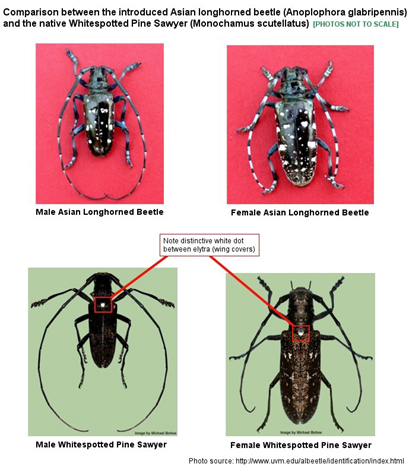Asian longhorned beetle vs. white-spotted pine sawyer: Spot the difference
The Asian longhorned beetle could be more devastating to Michigan’s forests than the emerald ash borer.

Ever reach for something on a store shelf only to find it was a “generic” brand instead of a major brand item you were looking for? Sure, we have all done it. Doing this in the store is almost always harmless, but making the same mistake when comparing the white-spotted pine sawyer and the Asian longhorned beetle could have devastating consequences for Michigan’s forests.
Mother Nature produces its own set of “look-a-like” species that can fool people who are otherwise unsuspecting. For example, two insects that have been confused for one another are different species of beetles that attack trees. These “look-a-likes” are the native white-spotted pine sawyer and the invasive Asian longhorned beetle (see photo comparison).
Spot the Difference
At a glance, the white-spotted pine sawyer and Asian longhorned beetle do look similar – particularly because of their large size, dark coloring and long antennae. But upon close inspection, there are differences. The body of the white-spotted pine sawyer beetle is browner in color, and the segments of its antennae are uniform in color and appearance. Also, the white-spotted pine sawyer has a distinctive white “dot” or spot between its head and at the top of its wing covers. This beetle only attacks dead or dying trees, including pines, spruces and other conifers, and poses no real harm to our Michigan forests. In comparison, the Asian longhorned beetle is a black-bodied beetle, and the segments of its antennae are black and white in appearance.

Male and female Asian longhorned beetle compared to male and female whitespotted pine sawyer. Photo source: http://www.uvm.edu/albeetle/identification/index.html
To date, the Asian longhorned beetle is not known to be present in Michigan but is on a “High Priority –Not Welcome Here” watch list by Michigan regulatory agencies because of its ability to kill host trees. The threat to Michigan posed by this invasive beetle is extremely severe and could possibly be more devastating than the emerald ash borer. This is because one of preferred hosts of the Asian longhorned beetle is sugar maple – which happens to be a very common tree species across Michigan. Therefore, this is one insect that is definitely NOT welcome in Michigan.
What you can do to help
But you do not have to be a trained entomologist to help Michigan avoid being infested with the Asian longhorned beetle. Michigan residents are encouraged to report any suspicious sightings of large beetles that they think look like the Asian longhorned beetle. In other words, “if in doubt, give a shout!”
Two good places to contact for help are your local Michigan State University Extension or Conservation District offices in Michigan. Both local offices have resources to help identify any suspected beetle and can submit the sample to other agencies in Michigan with trained entomologists, if needed.
Another way Michigan residents can help is by becoming a volunteer with the Michigan Eyes on the Forest and Sentinel Tree Network project. Sentinel Tree volunteers routinely monitor the health of trees on their property and report the data back to Michigan State University via the MISIN Eyes on the Forest website.



 Print
Print Email
Email


